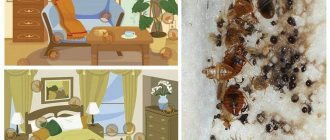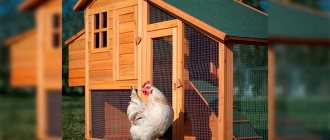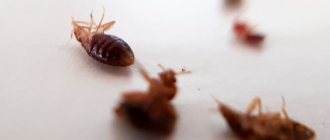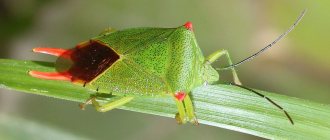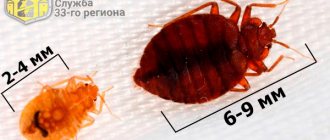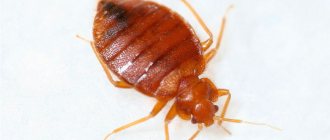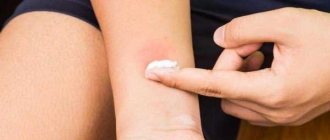Bedbugs can cause a lot of inconvenience to people. These ectoparasites feed on human blood, attacking victims mainly at night, so they set up their colonies where they can easily access food. Finding insect bites on the body and face in the morning, people often wonder whether bedbugs can live in pillows or blankets.
Bed bugs are blood-sucking parasites that feed on human blood.
Where do bedbugs most often live?
Bed bugs prefer to live in warm, dry places where there are holes and enough air.
Most often, insects can be found on the back walls of beds and sofas, inside mattresses, in armrests, sofa cushions, and ottomans. Their favorite material is foam rubber, since it is convenient to lay eggs in its pores.
In addition to upholstered furniture, ectoparasites are found:
- in the cracks of wooden furniture;
- for batteries;
- in picture frames;
- under baseboards;
- in the bedside table;
- inside sockets and electrical appliances;
- between books on shelves;
- in the carpet pile;
- under linoleum;
- under the peeling paint on the wall.
Parasites are found in the cracks of wooden furniture and beds.
Favorite habitats of bed bugs
The name “bed” speaks for itself. This type of bedbug prefers to live next to a person's bed. But they do not hide in underwear, but choose calmer and darker places:
- cracks in mattresses;
- free spaces in sofas and beds;
- various holes and bends in furniture.
The more parts there are in the furniture, the more convenient it is for insects to hide. The most favorable temperature for them is about 25 °C. It just coincides with a comfortable temperature for a person. This is not surprising, because since ancient times bedbugs have lived side by side with it, settling in caves, then in dugouts, huts, yurts, wooden and stone houses.
The bug feels best in a place where it can touch a hard surface with both its belly and back. That's why he chooses narrow crevices as his habitat. Often flat insects live behind baseboards, between book covers, and parts of armchairs and sofas.
Disinfection specialists find them under parquet floors, behind paintings and carpets hanging on the walls, and in old household appliances. Bedbugs love to live near radiators; they are even found in chests of drawers and closets with clothes.
In such places the air stagnates, there are no sudden changes in temperature, shocks, or vibrations, and it is very comfortable for a bug to live there. If conditions are disturbed, this will force insects to seek new shelter. In extreme cases, they may lie low and reduce their activity. This especially happens when the temperature drops. In cold conditions, bedbugs stop reproducing and go into suspended animation.
Can bedbugs live in pillows?
It is extremely rare for bedbugs to settle in pillows, since the fillings of these bedding items are made from bulk materials in which insects cannot move freely and lay eggs. At night, parasites emerge from secluded places where they hide during the day.
They crawl onto the pillow where a person sleeps to feed on his blood, and then return to their colonies.
Feather
Feather bedding can become a habitat for ectoparasites only if its filling is not cleaned for a long time. Feathers are not a suitable material for insects because they tend to clump and hinder their movement. In addition, feather pillows have thick pillowcases through which bloodsuckers cannot crawl inside the product.
Pillows and blankets can become habitats for bedbugs.
Pukhovs
Down, like feathers, cannot be called a suitable habitat for bedbugs. But if the filling of down pillows is not cleaned and dried, these insects can live in it, especially when there are a lot of them in the house.
kak-izbavitsya-ot-klopov-samim
Dear girls, this is a real problem, help, advise.
I wrote a long time ago that we have bedbugs, this was back in the late spring and summer, and now we still can’t get rid of them. We didn’t use thermonuclear weapons since we were children. They called the specialists, hounded them, calm down for a while and again, they also tried it themselves, but alas.
The problem is that we need to move to a new apartment, it’s tough, my father-in-law and mother-in-law forbid us to take anything other than our things. My father-in-law has already bought a crib, a mattress and a blanket for my son, every day they call and say that I didn’t take anything, no blankets, pillows, etc.
I understand everything, I myself am afraid that we’ll bring in the bastard and that’s it!
But it’s a pity, I have chests of drawers, a wardrobe, blankets, and, after all, clothes. What should I do?
After all, you can bring it with anything.
——-
pysy, I read some tips here, what a treat, I’m interested in whether they can be used to treat rugs, blankets, pillow covers, the pillows themselves, etc.
——————————————————
Since I receive a lot of messages asking how we got rid of bedbugs, I decided to write here.
I took a lot of advice from here, what the girls wrote to me, I did everything possible, without fear of ruining something!
The first thing we tried, a dermatologist advised us to buy some kind of product at the pharmacy that is diluted and sprayed, I don’t remember the name, but it didn’t really help us.
We also called the service, which is poisoning. It helped. But then the bedbugs appeared again.
I noticed that when it’s cold, there are none, but if it’s warm, then we’ve all been bitten!
In general, I took all the things from the closet and washed everything that was possible at 90 degrees, but I just washed everything that couldn’t. We had a lot of them on the curtains at the top, where the curtain rod was, and also in the sofa cover, in all sorts of folds, and the worst part was that they were hiding in the crib, where the side ties were.
We just threw away the sofa cover, curtains, blankets, pillows and much more, I put them in garbage bags and filled them with diclofos, tied the bags and put them on the balcony in the cold (it was in winter). Everything that I washed I also put on the balcony, children’s toys I washed and washed on the balcony too.
Since we were moving to a new apartment, we took almost nothing from the furniture, we moved things and I also left them in bags on the balcony, I took something necessary.
I hope this helps someone who needs it. Because it was just a nightmare, as I remember……….Good luck!
I see many people have this problem, many still write to me and ask. I am writing after years have passed. Everything is ok with us, ttt. With things and furniture too (it didn’t deteriorate, no new creatures appeared, etc.)
What to do first
First you need to make sure that there are blood-sucking parasites in the bedding or other places.
Their presence is indicated by:
- traces of insect activity, resembling dark-colored dots, on the surface of the bed;
- blood stains on pillowcases and sheets;
- the unpleasant smell of fermented raspberries emanating from the bedding;
- red itchy spots on the skin, located sequentially (appear after sleep).
Make sure that your sleeping areas are infested with blood-sucking parasites.
If these signs are detected, you need to take measures aimed at exterminating the bedbugs.
How to get rid of insects
To get rid of blood-sucking insects, different methods are used: mechanical, folk and chemical. Their choice depends on the preferences of the home owners, the number of parasites and other nuances.
Mechanical method
Since ectoparasites are found in bedding due to poor hygiene, you can get rid of them by cleaning the pillow. To do this, you need to undo the seams on the pillowcase, take out the filling and clean it. At home, this is most conveniently done by washing in hot water (from 50 °C) or steam treatment. The pillowcase should be washed and ironed thoroughly, paying special attention to the seams, as parasite eggs may remain in them. The dried filling is placed in the pillow, and the pillowcase is sewn up.
Washing and steaming will help get rid of insects that have infested a wool blanket. If pillows and blankets cannot be washed, they should be taken to the dry cleaner.
This method of fighting bedbugs is considered the simplest and least effective. To achieve the result, it must be carried out in parallel with chemical treatment of places where insects most often settle (the back of sofas, furniture crevices, etc.).
The mechanical method is the most effective.
Traditional methods
If you don’t want to use toxic chemicals in your home, you should try to get rid of bedbugs using the methods you used before:
- Dry or fresh branches of wormwood and tansy should be placed under the bed, on bedside tables and in other places where parasites accumulate. These plants are non-toxic, but bedbugs can't stand their smell, so they won't hang around them.
- In winter, you can try to freeze out the parasites. To do this, pillows and blankets must be left outside for 2-3 days at temperatures above -10 °C. Freezing destroys the adults and their eggs. In the summer, this method can also be used if you place the products in the freezer for several days.
What are these insects and where do they come from?
You can see what bed bugs look like in many photos on the Internet or in books. The blood-sucking individual has an oval body shape with a length of about eight millimeters. The size and color of the unwanted guest is determined by its degree of saturation. The color palette can start with light brown and end with a brown tint. After “eating,” the bug turns burgundy or black.
Many people wonder where pests come from in a house where order is regularly maintained and waste is disposed of on time. But these insects don’t care whether the home is dirty or clean. They will easily run to you from neighbors, or come with new things or furniture.
Understanding the reasons for the appearance of bloodsuckers in a home is not easy, because the source of infection includes not only adult individuals, but their eggs and larvae.
Paths of pest invasion:
- Unpleasant neighbors can be brought in in bags or on clothes by guests, owners, builders (if the apartment is undergoing renovation);
- Insects are prone to “migration” from another apartment through ventilation ducts, through a gap in baseboards or walls;
- Pets that roam outside can carry parasites on their fur;
- When purchasing furniture and clothing “from hand”. Such things may become contaminated. Even buying new furniture will not give a 100% guarantee that there will be no bloodsuckers;
- If disinfestation is carried out in a neighboring home, the insects will look for a new habitat;
- If the basement is in poor condition (rodents, stray animals, dampness).
When people move into purchased but not new housing, which seems quite clean, they often ask the question: where do bed bugs come from in the apartment? Unwanted guests hibernate for a long time if there is no “food”, and when new owners move into the house they become more active.
Chemicals
Traditional methods will be effective if there are no large colonies of parasites in the house. When there are a lot of bloodsuckers, chemical industry products will come to the rescue.
"Delta Zone"
Belongs to the category of low-toxic drugs. It is produced in the form of a microencapsulated suspension based on deltamethrin 2.5%, which must be diluted with water in accordance with the instructions. The product destroys adult insects, larvae and egg laying. Valid for 8 weeks. It has no unpleasant odor and does not pose a danger to people, animals and plants. The drug does not leave burns or other marks on the skin. After disinsection treatment, you need to ventilate the room for 30 minutes.
“Delta Zone” is an insecticidal agent that is intended to kill bedbugs.
"Get Total"
Microencapsulated insecticide in the form of a solution intended for dilution in water. The active ingredient of the drug is chlorpyrifos, a substance that has a toxic effect on bed bugs and other harmful insects. "Get Total" destroys parasites within 2 and a half hours after direct spraying and remains on surfaces for 3-4 days, continuing its effect.
Thanks to this, there is no need to carry out repeated disinfestation. The product has no toxic effect on people and animals.
"Executioner"
A highly concentrated solution whose insecticidal effect is provided by fenthion. Designed for direct spraying. If the drug gets into the spiracles, bed bugs live no more than 8 and a half minutes. After drying, it remains toxic for 19 hours.
“Executioner” is a modern remedy, quite effective.
“Executioner” has a specific smell, which disappears after airing. You can return to the room where the drug was treated after 2 hours. The dried solution remaining on surfaces after applying the product contains a minimal amount of fenthion and is not dangerous for people and animals.
"Pyrethrum"
A distinctive feature of “Pyrethrum” is its naturalness. The drug is based on dried Dolmat chamomile flowers and is produced in the form of a powder intended for preparing a solution. It is toxic to all crawling insects, but is safe for humans and animals. This organic insecticide upon contact causes paralysis of the nervous system of parasites and their death.
The solution prepared from the powder has a pleasant floral aroma. After treatment, the room may not be ventilated. Toxic substances contained in Pyrethrum disintegrate in air and do not require rinsing off.
"Combat SuperSpray"
Aerosol “Combat SuperSpray” destroys bedbugs and their clutches thanks to the substance imiprotrin. Has a fruity smell. Easy to use: just spray on insects and also treat their habitats. The manufacturer promises instant destruction of parasites and prolonged action. After disinsection, the room should be ventilated for half an hour. "Combat SuperSpray" is allowed to be used in residential premises.
“Combat SuperSpray” is a Korean broad-spectrum insecticide.
"Xulat Micro"
The insecticide is available in the form of an odorless suspension that is safe for people and pets. Immediately 3 active components in the composition of the drug (tetramethrin, cypermethrin and piperonyl butoxide) have a paralyzing effect on ectoparasites and cause their death after 30 minutes. The drug may not be removed from surfaces, in which case it will prevent the appearance of bedbugs for another six months.
"Cucaracha"
Concentrated solution "Cucaracha" contains FOS-malathion and pyrethroid-cypermethrin. Thanks to the action of 2 components, the drug destroys bedbugs within an hour after disinfestation. It has an unpleasant odor, so you need to use it with a respirator and with open windows. After treatment, it is necessary to ventilate the room for 3 hours and carry out wet cleaning using a soap-soda solution. There is no need to rinse off the product in crevices and other hard-to-reach places.
“Cucaracha” is a concentrated solution for bedbugs.
"Cifox"
Cypermethrin concentrate "Cifox" is highly effective in fighting bedbugs, but due to its toxicity it is undesirable to use it in residential areas. If you decide to fight parasites using this product, after disinfestation you need to thoroughly wipe all treated surfaces and ventilate the room.
City residents are terrorized by bedbugs and their “liquidators”
TOPPED “SURPRISE”
If earlier bedbugs and cockroaches appeared exclusively in dirty apartments, now they have begun to settle in decent houses. What happened?
And such fears of citizens, which from the outside may seem like paranoia, in many cases turn out to be... justified. After such announcements, insects actually begin to appear in hallways and apartments. There is a heated discussion about this on Internet forums.
“We’ve been fighting bedbugs for a year, but they started appearing right from the moment the advertisements were posted,” writes Olga Demidova, a resident of the capital.
Footage even appeared online of an employee of one of these services planting bedbugs in the mailboxes of Pushkino residents. Another, before posting a notice about the extermination of insects, throws something at the electrical panel.
According to Rospotrebnadzor specialists, attics can be a breeding ground for bedbugs (if pigeons nest in them). And rarely, but it happens, you can pick up a bug on public transport.
How to choose a method for treating bedding against bedbugs
When processing pillows and blankets, preference should be given to methods that do not harm the health of the residents of the house. It is recommended to resort to mechanical and folk methods, and if their action is not enough, then use chemicals. When choosing the latter, you should avoid treating your sleeping area with toxic drugs such as Cucarachi and Tsifoxa, since they can cause headaches, vomiting and other signs of toxic poisoning in the bedroom inhabitants.
It is better to use odorless insecticides with proven safety for human health.
General scheme of actions
The most reliable way is to seek the help of professionals and call a pest control service, but they resort to it quite rarely, including because of a feeling of shame. Most people try to remove bed bugs on their own.
Remember: although we are talking about bed bugs, they can nest not only in the bed, but also in carpets, baseboards, wallpaper, furniture, and not even in the immediate vicinity of the sleeping area, so a considerable area will have to be treated, including without fail all soft furniture.
Bedbug nesting sites
Chemical agents are most effective, but they are not safe for health, so before treatment you will have to remove children, allergy sufferers, and pets from the apartment for several days.
- Be sure to remove all food and hygiene items.
- It is best to boil bed linen or, at a minimum, wash it at a temperature of at least 60°C, and then carefully iron it with a very hot iron, preferably with steam, on both sides. The same applies to curtains.
- It is best to dry clean carpets, pillows, blankets and mattresses.
- The furniture must be moved away from the walls to such a distance that the back wall and baseboard can be treated.
Useful tips
To avoid the appearance of bed bugs, you should buy pillows and blankets made of synthetic materials, since parasites do not live in such products. In addition, bedding with artificial fillings can be washed in a washing machine, which is not possible with feather and down pillows and blankets.
If you cannot get rid of blood-sucking insects on your own, then it is better to invite specialists to your home. Disinfectors will quickly find all the locations of bedbugs and, using modern means, destroy adult parasites, their larvae and eggs even in the smallest cracks, completely ridding the house of uninvited guests.
Bedbugs inside the mattress.
On the inner surface of the mattress, usually in the places of seams, tags, ventilation, handles, bedbugs form nests, but they are rarely found inside the mattress.
Some mattress manufacturers have taken care of the safety of their customers, so modern mattresses are sealed and protected from insects getting inside, but they have one drawback, this is a huge internal space and if there is damage on the mattress, in the form of holes, the seams have come apart, bed bugs can settle inside and begin to reproduce.
Bedbugs do not live in Soviet mattresses; they are very tightly stuffed with cotton wool.

